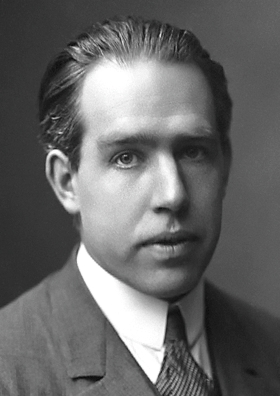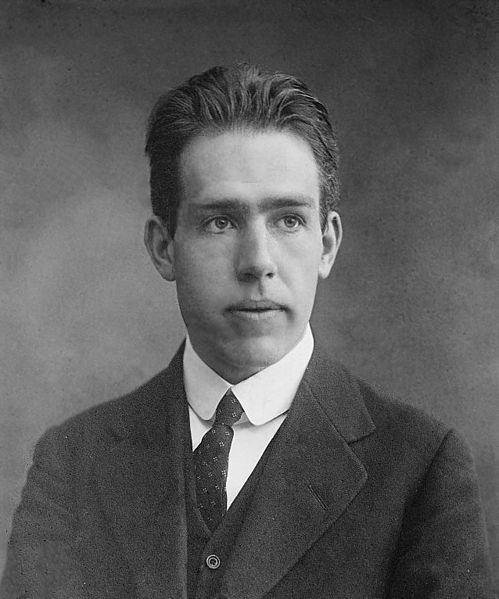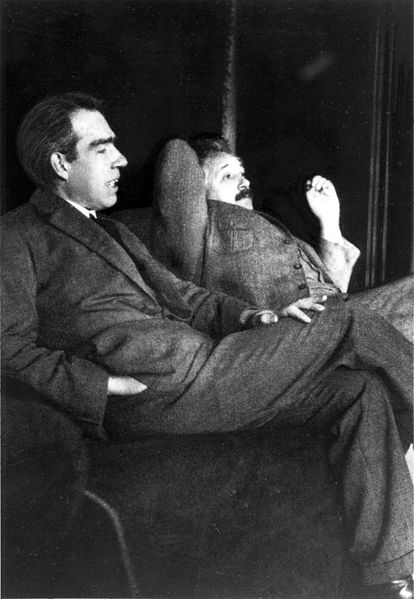<Back to Index>
- Physicist Niels Henrik David Bohr, 1885
PAGE SPONSOR



Niels Henrik David Bohr (7 October 1885 – 18 November 1962) was a Danish physicist who made foundational contributions to understanding atomic structure and quantum mechanics, for which he received the Nobel Prize in Physics in 1922. Bohr mentored and collaborated with many of the top physicists of the century at his institute in Copenhagen. He was part of the British team of physicists working on the Manhattan Project. Bohr married Margrethe Nørlund in 1912, and one of their sons, Aage Bohr, grew up to be an important physicist who in 1975 also received the Nobel Prize. Bohr has been described as one of the most influential scientists of the 20th century.
Bohr was born in Copenhagen, Denmark, in 1885. His father,
Christian Bohr, was professor of physiology at the University of
Copenhagen (it is his name which is given to the Bohr shift or Bohr
effect), while his mother, Ellen Adler Bohr, came from a wealthy Jewish
family prominent in Danish banking and parliamentary circles (in 1891,
Bohr was baptized a Lutheran, his father's religion). Despite having a
religious background, he later became an atheist. His brother was Harald
Bohr, a mathematician and Olympic footballer who played on the Danish
national team. Niels Bohr was a passionate footballer as well, and the
two brothers played a number of matches for the Copenhagen based
Akademisk Boldklub, with Niels in goal.
In 1903 Bohr enrolled as an undergraduate at Copenhagen University, initially studying philosophy and mathematics. In 1905, prompted by a gold medal competition sponsored by the Royal Danish Academy of Sciences and Letters, he conducted a series of experiments to examine the properties of surface tension, using his father's laboratory in the university, familiar to him from assisting there since childhood. His essay won the prize, and it was this success that decided Bohr to abandon philosophy and adopt physics. He continued as a graduate student at the University of Copenhagen, under the physicist Christian Christiansen, receiving his doctorate in 1911.
As a post doctoral student, Bohr first conducted experiments under J. J. Thomson, of Trinity College, Cambridge, and Cavendish Laboratory. In 1912 he met and later joined Ernest Rutherford at Manchester University, where on and off he spent four fruitful years in association with the older physics professor. In 1916, Bohr returned permanently to the University of Copenhagen, where he was appointed to the Chair of Theoretical Physics, a position created especially for him. In 1918 he began efforts to establish the University Institute of Theoretical Physics, which he later directed.
Earlier in 1910 Bohr had met Margrethe Nørlund, sister of the mathematician Niels Erik Nørlund. They were married in Copenhagen in 1912.
Of their six sons, the oldest died in a boating accident and another
died from childhood meningitis. The others went on to lead successful
lives, including Aage Bohr,
who became a very successful physicist and, like his father, was
awarded the Nobel Prize in physics, in 1975. His other sons were Hans
Henrik, a physician, Erik, a chemical engineer, and Ernest, a lawyer.
In 1922, Bohr was awarded the Nobel Prize in physics "for his services in the investigation of the structure of atoms and of the radiation emanating from them." The award recognized his early leading work in the emerging field of Quantum Mechanics.
While at Manchester University, Bohr had adapted Rutherford's nuclear structure to Max Planck's quantum theory and so obtained a model of atomic structure which, with later improvements – mainly as a result of Heisenberg's concepts – remains valid to this day. Bohr published his model of atomic structure in 1913. Here he introduced the theory of electrons traveling in orbits around the atom's nucleus, the chemical properties of each element being largely determined by the number of electrons in the outer orbits of its atoms. Bohr also introduced the idea that an electron could drop from a higher energy orbit to a lower one, in the process emitting a photon (light quantum) of discrete energy. This became a basis for quantum theory.
Among the international community of nuclear physicists, Bohr came to
play the role of convener of discussion groups and lectures, as well as
being a mentor and an advisor. With the assistance of the Danish
government and the Carlsberg Foundation, he succeeded in founding the
Institute of Theoretical Physics in 1921, of which he became director.
Bohr's institute served as a focal point for researchers into Quantum
Mechanics and related subjects in the 1920s and 1930s, when most of the
world's best known theoretical physicists spent some time in his
company. Bohr became widely appreciated as their congenial host and
eminent colleague, both at the Institute and at the Foundation's mansion
in Carlsberg, where he and his family resided after 1932.
Bohr also conceived the principle of complementarity: that items could be separately analyzed as having several contradictory properties. For example, physicists currently conclude that light behaves either as a wave or a stream of particles depending on the experimental framework – two apparently mutually exclusive properties – on the basis of this principle. Bohr found philosophical applications for this daring principle. Albert Einstein much preferred the determinism of classical physics over the probabilistic new quantum physics (to which among many others Einstein himself had 'unwittingly' contributed). Philosophical issues that arose from the novel aspects of Quantum Mechanics became widely celebrated subjects of discussion. Einstein and Bohr had good natured arguments over such issues throughout their lives (Bohr – Einstein debates).
Werner Heisenberg
worked as an assistant to Bohr and university lecturer in Copenhagen
from 1926 to 1927. It was in Copenhagen, in 1927, that Heisenberg
developed his uncertainty principle, while working on the mathematical
foundations of quantum mechanics. Heisenberg later became head of the
German nuclear energy project. In April 1940, early in World War II,
Germany invaded and occupied Denmark. In September 1941, Bohr was
visited by Heisenberg in Copenhagen.
In September 1943, reliable word reached Bohr about his imminent arrest by the German police; the Danish resistance quickly managed to help Bohr and his wife escape by sea to Sweden. Soon after, Bohr was flown in a military aircraft to Britain. There he was introduced to the then secret atomic bomb project. Eventually he was directed to the project's principal location in the United States.
Bohr worked on the Manhattan Project at the top secret Los Alamos laboratory in New Mexico, where he was known by the name of Nicholas Baker for security reasons. His role on the project was as the knowledgeable consultant or "father confessor". He often expressed social concern about such weaponry and an eventual nuclear arms race, and is quoted as saying, "That is why I went to America. They didn't need my help in making the atom bomb."
Bohr believed that atomic secrets should be shared by the international scientific community. After meeting with Bohr, J. Robert Oppenheimer suggested that Bohr visit President Franklin D. Roosevelt to convince him that the Manhattan Project should be shared with the Russians in the hope of speeding up its results. Roosevelt suggested that Bohr return to the United Kingdom to try to win British approval. Winston Churchill disagreed with the idea of openness towards the Russians to the point that he wrote in a letter: "It seems to me Bohr ought to be confined or at any rate made to see that he is very near the edge of mortal crimes."
Following the war Bohr returned to Copenhagen. He continued to
advocate the peaceful use of nuclear energy. When awarded the Order of
the Elephant by the Danish government, he designed his own coat of arms
which featured a taijitu (symbol of yin and yang) and the motto in Latin: contraria sunt complementa: "opposites are complementary". He died in Copenhagen in 1962 of heart failure. He is buried in the Assistens Kirkegård in the Nørrebro section of Copenhagen.
- The Bohr model of the atom, the theory that electrons travel in discrete orbits around the atom's nucleus.
- The shell model of the atom, where the chemical properties of an element are determined by the electrons in the outermost orbit.
- The correspondence principle, the basic tool of Old quantum theory.
- The liquid drop model of the atomic nucleus.
- Identified the isotope of uranium that was responsible for slow - neutron fission – 235U.
- Much work on the Copenhagen interpretation of quantum mechanics.
- The principle of complementarity: that items could be separately analyzed as having several contradictory properties.
"Tube Alloys" was the code name for the British nuclear weapon program. British intelligence inquired about Bohr's availability for work or insights of particular value. Bohr's reply made it clear that he could not help. This reply, like his reaction to Heisenberg, made sure that if Gestapo intercepted anything attributed to Bohr it would point to no knowledge regarding nuclear energy as it stood in 1941. This does not exclude the possibility that Bohr privately made calculations going further than his work in 1939 with Wheeler.
The allied powers learned in 1944 that Germany had no atomic weapons. Bohr hoped then that greater atomic armament could be prevented by some new international agreements, before the weapons were used in the war. He also hoped that new contacts could be established between the Western and Russian nuclear scientists, as signs of cooperation between the soon - to - be victorious powers in the war. Bohr's friend Supreme Court Justice Felix Frankfurter informed President Roosevelt about Bohr's opinions, and a meeting between them was organized 26 August 1944. President Roosevelt, however, did not agree with Bohr. The British Prime Minister Winston Churchill also refused, after a meeting with Bohr 16 May 1944. He disagreed with the idea of any openness towards the Russians to the point that he wrote in a letter: "It seems to me Bohr ought to be confined or at any rate made to see, that he is very near the edge of mortal crimes."
After leaving Denmark in the dramatic day and night (October 1943) when most Jews were able to escape to Sweden due to exceptional circumstances (Rescue of the Danish Jews), Bohr was quickly asked again to join the British effort and he was flown to the UK. He was evacuated from Stockholm in 1943 in an unarmed De Havilland Mosquito operated by British Overseas Airways Corporation (BOAC). Passengers on BOAC's Mosquitos were carried in an improvised cabin in the bomb bay. The flight almost ended in tragedy as Bohr did not don his oxygen equipment as instructed and passed out at high altitude. He would have died had not the pilot surmising from Bohr's lack of response to intercom communication that he had lost consciousness, descended to a lower altitude for the remainder of the flight. Bohr's comment was that he had slept like a baby for the entire flight.
As part of the UK team on "Tube Alloys" Bohr went to Los Alamos. Oppenheimer credited Bohr warmly for his guiding help during certain discussions among scientists there. Discreetly, he met President Franklin D. Roosevelt and later Winston Churchill to warn against the perilous perspectives that would follow from separate development of nuclear weapons by several powers rather than some form of controlled sharing of the knowledge, which would spread quickly in any case. Only in the 1950s, after the Soviet Union's first nuclear weapon test, was it possible to create the International Atomic Energy Agency along the lines of Bohr's suggestion.
Bohr advocated informing the Soviet authorities that the atomic bomb
would soon be in use. In 1944 he obtained an audience with Winston
Churchill, who became worried about whether Bohr was a security risk. In 1950 he addressed an 'Open Letter' to the United Nations.
Bohr and Werner Heisenberg enjoyed at first a strong relationship. It began as one between a mentor and his protégé. Bohr had become aware of Heisenberg's talent during a lecture Heisenberg gave in Göttingen in 1922. During the mid 1920s, Heisenberg worked with Bohr at the institute in Copenhagen. Heisenberg, like most of Bohr's assistants, learned Danish. Heisenberg's uncertainty principle was developed during this period, as was Bohr's complementarity principle.
During the 1930s, however, the relationship became constricted due to political developments in Germany. During World War II, Bohr, who was of half Jewish ancestry, remained for several years in occupied Denmark. Heisenberg in Germany had become head of the German nuclear effort. Heisenberg made a famous visit to Bohr in September 1941. During a private moment outside with Bohr, Heisenberg, it seems, began to address nuclear energy and morality as well as the war. Neither Bohr nor Heisenberg spoke about it in any detail and left few written records of this part of the meeting, when they were alone. Bohr seems to have reacted by terminating that conversation abruptly while not giving Heisenberg hints in any direction.
While some suggest that the relationship became strained at this
meeting, other evidence shows that the level of contact had been reduced
considerably for some time already. Heisenberg suggested that the
fracture occurred later. In correspondence to his wife, Heisenberg
described the final visit of the trip: "Today I was once more, with
Weizsäcker, at Bohr's. In many ways this was especially nice, the
conversation revolved for a large part of the evening around purely
human concerns, Bohr was reading aloud, I played a Mozart Sonata
(A-Major)."
Ivan Supek, one of Heisenberg's students and friends, claimed that the
main figure of the meeting was actually Weizsäcker who tried to persuade
Bohr to mediate peace between Great Britain and Germany.
In 1957, while the author Robert Jungk was working on the book Brighter Than a Thousand Suns, Heisenberg wrote to Jungk explaining that he had visited Copenhagen to communicate to Bohr the views of the German scientists, that production of an atomic weapon was possible with great efforts and this raised enormous responsibilities on the worlds scientists on either side. But Bohr was shocked by the news, that Heisenberg was involved in such studies. And the conversation went wrong because of this. The German attempts were mostly focused on energy production and Heisenberg's circle of colleagues tried probably to keep it that way. Heisenberg acknowledged that his cryptic approach of the subject had so alarmed Bohr that the discussion failed. Heisenberg nuanced his claims and avoided the implication that he and his colleagues had sabotaged the bomb effort. The production of the bomb in USA showed that it craved enormous resources, which was never considered in this scale in Germany during the war.
When Bohr saw Jungk's erroneous depiction in the Danish translation of the book, he disagreed. He drafted (but never sent) a letter to Heisenberg, stating that he never understood the purpose of Heisenberg's visit and was shocked by Heisenberg's opinion that Germany would win the war. And atomic weapons could be decisive in a long war. Bohr had described the possibility of an atomic weapon in a lecture in England 1939.
Michael Frayn's play Copenhagen
(1998), which was performed in London (for five years), Copenhagen,
Gothenburg, Rome, Athens and Geneva and on Broadway in New York,
explores what might have happened at the 1941 meeting between Heisenberg
and Bohr. Frayn points in particular to the onus of being one of the
few to understand what it would mean to create a nuclear weapon.
It is generally accepted that Bohr read the 19th century Danish Christian existentialist philosopher, Søren Kierkegaard. Richard Rhodes argues in The Making of the Atomic Bomb that Bohr was influenced by Kierkegaard via the philosopher Harald Høffding, who was strongly influenced by Kierkegaard and who was an old friend of Bohr's father. In 1909, Bohr sent his brother Kierkegaard's Stages on Life's Way as a birthday gift. In the enclosed letter, Bohr wrote, "It is the only thing I have to send home; but I do not believe that it would be very easy to find anything better.... I even think it is one of the most delightful things I have ever read." Bohr enjoyed Kierkegaard's language and literary style, but mentioned that he had some "disagreement with [Kierkegaard's ideas]."
Given this, there has been some dispute over whether Kierkegaard influenced Bohr's philosophy and science. David Favrholdt
argues that Kierkegaard had minimal influence over Bohr's work, taking
Bohr's statement about disagreeing with Kierkegaard at face value, while
Jan Faye
endorses the opposing point of view by arguing that one can disagree
with the content of a theory while accepting its general premises and
structure.
- He was one of the founding fathers of CERN in 1954.
- Received the first ever Atoms for Peace Award in 1957.
- In 1965, three years after Bohr's death, the Institute of Physics at the University of Copenhagen changed its name to the Niels Bohr Institute.
- The Bohr models semi - centennial was commemorated in Denmark on 21 November 1963 with a postage stamp depicting Bohr, the hydrogen atom and the formula for the difference of any two hydrogen energy levels:
 .
. - Bohrium (a chemical element, atomic number 107) is named in honor of Bohr.
- Hafnium, another chemical element, whose properties were predicted by Bohr, was named by him after Hafnia, Copenhagen's Latin name.
- Asteroid 3948 Bohr is named after him.
- The Centennial of Bohr's birth was commemorated in Denmark on 3 October 1985 with a postage stamp depicting Bohr with his wife Margrethe.
- In 1997 the Danish National Bank started circulating the 500-krone banknote with the portrait of Bohr smoking a pipe.